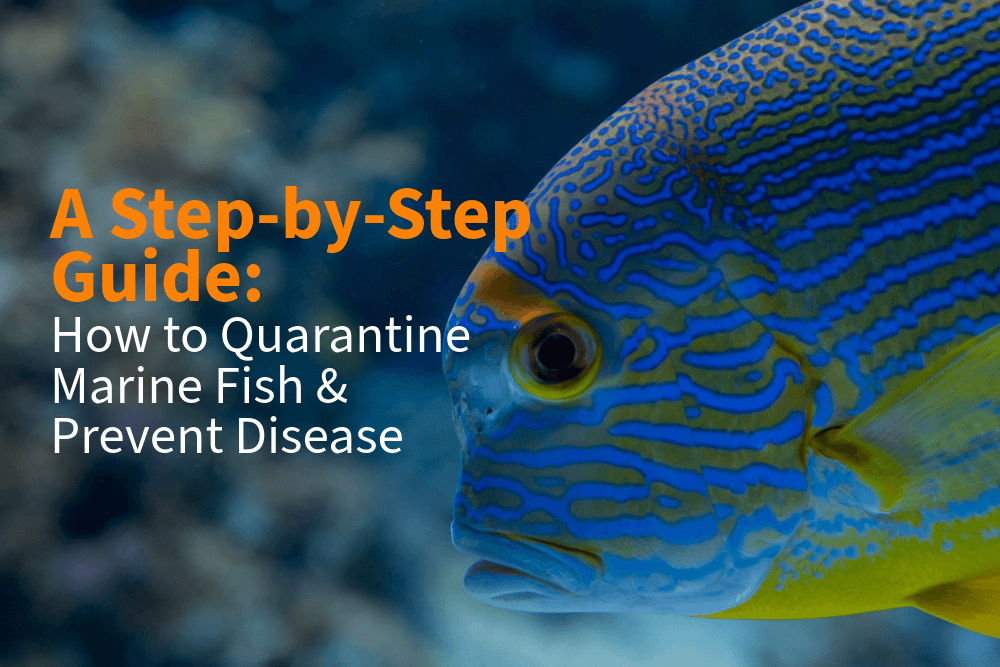Introducing new marine fish to your aquarium is exciting—but without proper quarantine procedures, it can also be risky. Parasites, bacterial infections, and stress-related illnesses can spread quickly in a marine system, threatening the health of your entire tank.
At Perfect Aquatics, we always recommend quarantining new fish before adding them to your main display, obviously this isn't always possible and is dependent on your individual setup, budget and approach. In this guide, we’ll walk you through why quarantine is beneficial, how to set up a quarantine tank, and what steps to take to prevent the spread of disease in your marine aquarium.
Why Quarantine Marine Fish?
Quarantine gives new fish time to adjust to captive conditions while allowing you to monitor and treat them for potential illnesses—before they can infect your main tank.
Key Benefits:
-
Prevents the spread of parasites like marine ich (Cryptocaryon irritans)
-
Allows safe administration of medication without disrupting your display tank
-
Reduces stress and helps fish acclimate gradually
-
Gives time to observe appetite, behaviour, and signs of disease
Even fish from reputable suppliers can carry invisible pathogens. Quarantine is your first line of defence.
What You'll Need for a Marine Quarantine Setup
A basic quarantine tank doesn’t need to be complex or expensive. Here’s what we recommend:
Tank Size:
-
40–80 litres (10–20 gallons) is suitable for most marine fish
-
Use a simple glass tank or nano setup
Filtration & Circulation:
-
Sponge filter or hang-on-back filter (matured or seeded if possible)
-
Small powerhead for circulation
Heater & Thermometer:
-
Maintain temperature at 24–26°C (75–78°F)
Lighting:
-
Standard LED lighting—nothing fancy needed
-
Dim lighting helps reduce stress
Hiding Spots:
-
Use PVC pipes, ceramic caves, or clean rock for shelter
-
Avoid live rock—it can absorb medications
Water Quality:
-
Test ammonia, nitrite, nitrate, salinity, pH daily
-
Perform frequent water changes to maintain pristine conditions
Step-by-Step Quarantine Process for Marine Fish
1. Acclimate the Fish Properly
Use the drip acclimation method to slowly introduce the fish to your quarantine water parameters, reducing stress and shock.
2. Observe Without Medication (First 2–5 Days)
Let the fish settle and monitor for visible signs of illness:
-
Clamped fins
-
Flashing or rubbing
-
Laboured breathing
-
White spots or discolouration
-
Loss of appetite
3. Treat Preventively (Optional but Recommended)
After the observation period, consider prophylactic treatment based on your quarantine philosophy.
Common options include:
-
Copper-based treatments – for parasites like marine ich
-
Formalin or freshwater dips – for external parasites
-
Praziquantel – for flukes and internal worms
-
Antibiotics – if bacterial infection is suspected
Always research the compatibility of medications with the fish species you're treating. Some are copper-sensitive (e.g. wrasses, gobies).
Marine Fish Medications & Treatments
4. Feed High-Quality, Nutritious Foods
Boost immune health with a varied diet:
-
Frozen mysis, brine shrimp, enriched pellets
-
Garlic additives or immune boosters
5. Quarantine Duration
-
Standard quarantine time: 2–4 weeks
-
Extended to 6 weeks if any treatment or illness occurs
-
Observe until fish are eating well and show no symptoms
Tips to Prevent Disease in Your Main Display Tank
Even with a quarantine process, maintaining long-term fish health requires good habits:
Maintain Stable Water Parameters
-
Keep salinity, temperature, and pH within ideal ranges
-
Use a reliable auto top-up system to reduce fluctuations
Avoid Overstocking
-
Overcrowded tanks lead to stress, aggression, and lowered immunity
Don’t Share Equipment
-
Use dedicated nets and tools for the quarantine tank
Never Skip Quarantine (Even for Invertebrates & Corals)
-
Many pests and parasites arrive on coral plugs and live rock
-
Consider using a coral dip and separate QT tank for new inverts
Final Thoughts: A Simple Step That Saves Your Tank
Quarantining new marine fish might feel like extra effort—but it’s one of the best ways to ensure a healthy, thriving saltwater aquarium. Taking the time to observe, acclimate, and treat new arrivals can prevent disasters down the line.
At Perfect Aquatics, we stock a full range of quarantine tanks, medications, water conditioners, marine foods, and testing kits to make the process simple and effective.
Visit our Bedfordshire store or shop online for everything you need to protect your reef.

